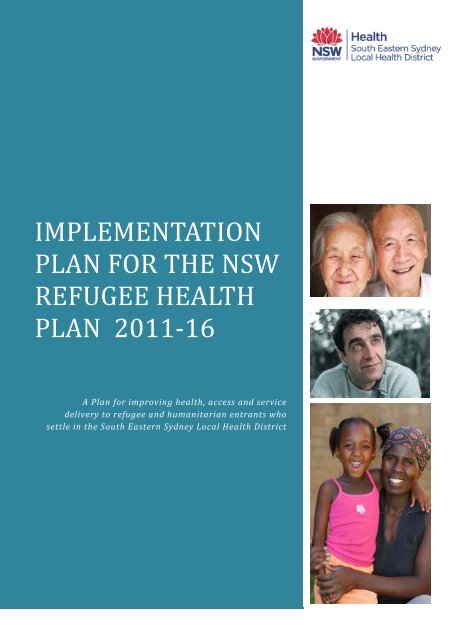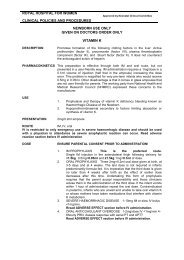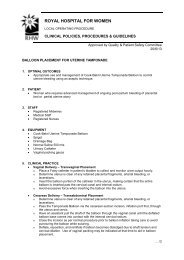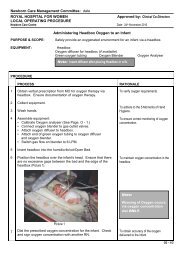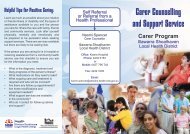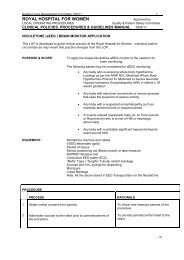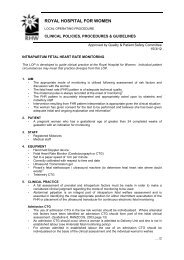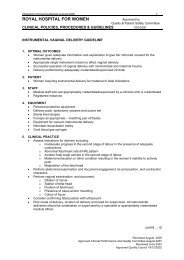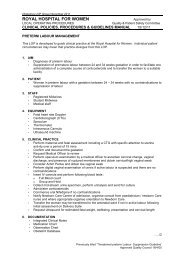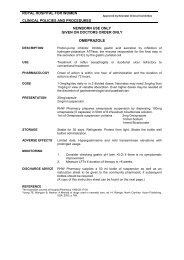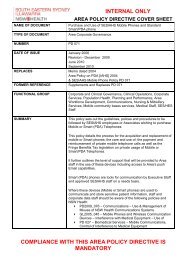South EAstern sydney LOCAL HEALTH DISTRICT REFUGEE ...
South EAstern sydney LOCAL HEALTH DISTRICT REFUGEE ...
South EAstern sydney LOCAL HEALTH DISTRICT REFUGEE ...
Create successful ePaper yourself
Turn your PDF publications into a flip-book with our unique Google optimized e-Paper software.
IMPLEMENTATIONPLAN FOR THE NSW<strong>REFUGEE</strong> <strong>HEALTH</strong>PLAN 2011-16A Plan for improving health, access and servicedelivery to refugee and humanitarian entrants whosettle in the <strong>South</strong> Eastern Sydney Local Health District
ForewordIt is with great pleasure that I present to you the <strong>South</strong> Eastern Sydney Local Health DistrictImplementation Plan for the NSW Refugee Health Plan 2011 – 2016.The SESLHD Refugee Health Implementation Plan aims to build on the achievements of theformer <strong>South</strong> Eastern Sydney Illawarra Area Health Service (SESIH) Refugee Health program, andprepare the Local Health District to best meet the challenges of improving the health andsettlement outcomes for people from refugee and refugee-like backgrounds living in our District.Over the past four years there have been a number of significant policy developments at the Statelevel that are relevant to refugee health. The NSW Refugee Health Plan 2011-2016 which outlineseight strategic priorities for improving the health and well being of refugees and asylum seekersand includes a best practice model for refugee healthcare. NSW Health Policy & ImplementationPlan for Healthy Culturally Diverse Communities 2012-2016, the strategic state-wide policy forimproving the health of NSW residents from backgrounds which are culturally, religiously andlinguistically diverse. This plan serves as NSW Health's multicultural forward plan under the NSWMulticultural Policies and Services Program and identifies refugees as a priority population whoexperience poorer health outcomes than other migrants. The NSW Multicultural Mental HealthPlan 2008-2012 also identified refugees and torture and trauma survivors as an at risk populationgroup.Another major development was commencement of the Refugee Health Nurse program inmetropolitan Sydney, centrally coordinated by the NSW Refugee Health Service and offeringoutreach services to our District.Underpinning the development of the SESLHD Refugee Health Implementation Plan is therecognition of the key service provision roles of refugee health nurses, General Practitioners,specialist health professionals and multicultural health services. A key principle underpinning theplan was working in partnership with key service partners, including the Sydney Children’s HospitalNetwork, and state wide organisations, such as the NSW Refugee Health Service and the NSWService for the Treatment and Rehabilitation of Torture and Trauma Survivors. The plan alsorecognises the importance of consulting with communities and non-government organisations tohelp inform the decisions about healthcare priorities.Accordingly, a Refugee Health Coordination Group was established in June 2012 to lead theplanning and implementation process. The group is led by the Multicultural Health Service andcomprises representatives from the above mentioned services as well as key SESLHD clinical andnon-clinical services and programs.It is only through a sustained commitment to working together that we will improve the health andwellbeing for people of refugee and refugee-like backgrounds living in <strong>South</strong> Eastern Sydney.Terry CloutChief Executive<strong>South</strong> Eastern Sydney Local Health District2
Executive SummaryThe <strong>South</strong> Eastern Sydney Local Health District Refugee Health Implementation Plan has beendeveloped in response to the NSW Refugee Health Plan 2011-2016 which outlines eight strategicpriorities and included a best practice model for refugee healthcare. Central to the best practicemodel are Refugee Health Nurses who conduct on-arrival health assessments with follow upcomprehensive health assessments by General Practitioners (GPs) or specialised refugee healthclinics.In 2011-12, the NSW government allocated $1.5 million dollars per annum to expand the programof Refugee Health Nurses (RHNS) across NSW. As a result, in metropolitan Sydney, the NSWRefugee Health Service (RHS) has increased the pool of Refugee Health Nurses and expandedtheir outreach services. This included a population based allocation of FTE 0.2 of outreachservices to <strong>South</strong> Eastern Sydney Local Health District (SESLHD).The former <strong>South</strong> Eastern Sydney Illawarra Health (SESIH) demonstrated a significant interest inand commitment to the health of refugees. The achievements of the SESIH Refugee HealthProgram are summarised in this document.The refugee population in SESLHD is characterised by a small but significant number of newHumanitarian arrivals per year (approximately 150 people) from countries such as China, Iran,Iraq, Egypt and Bangladesh. There is also a significant older refugee population, particularly in theEastern Suburbs.Key partners in developing and delivering the initiatives of the SESLHD Refugee HealthImplementation Plan are:• SESLHD Multicultural Health Service• Sydney Children’s Hospital Network, Randwick Campus• NSW Refugee Health Service• NSW Service for the Treatment and Rehabilitation of Torture and Trauma Survivors• Asylum Seeker Centre of New <strong>South</strong> Wales• Settlement services• Medicare Locals• Health Language Services• Diversity Health Coordinators in SESLHD hospital facilities• Child Youth Women and Family Health• Key services within SESLHD, including Women’s Health, Public Health Unit, InfectiousDiseases, Mental Health, Maternal and Child Health, Youth Health, Sexual Health, OralHealth, Chest Clinics, Aged Care• Consumer representatives/community members/advocatesThe immediate priorities identified in the SESLHD Refugee Health Implementation Plan are:• to establish a SESLHD Refugee Health Coordination Group (RHCG) to oversee theimplementation of the plan• to implement the best practice model of refugee healthcare in SESLHD• to continue to implement the targeted health screening in Beverley Hills Intensive EnglishCentre• to continue the longitudinal study of refugee children in their first three years of settlement• to conduct a forum on the health needs of older refugees3
IntroductionRefugees and asylum seekersThe 1951 United Nations Convention relating to the Status of Refugees defines refugees as peoplewho are outside of their country of nationality or habitual residence, and havea well-founded fear of persecution because of their race, religion, nationality, membership of aparticular social group or political opinion 1 .Asylum seekers, also known as ‘offshore applicants’ are people who have arrived in Australia andhave lodged an application for refugee status. If successful, they will be granted permanentprotection and residency in Australia. Asylum seekers who arrived in Australia with a valid visa(student, tourist visas etc) are able to live in the community while their refugee status is beingdetermined. Those who arrived without a valid visa are held in Immigration Detention Centres ofcommunity detention. Entitlements for healthcare and social support services vary depending onvisa type (see Appendix 3). In 2009, NSW Health approved fee waivers for specified public healthservices to community based asylum seekers who are Medicare ineligible 2 .For the purpose of this plan, the term refugee will be used to encompass people arriving inAustralia on refugee/humanitarian visas, asylum seekers applying for refugee status in Australiaand people of refugee-like background who have arrived under the Family Migration or otherprograms.Policy and Planning ContextThe SESLHD Refugee Health Implementation Plan has been developed in response to the NSWRefugee Health Plan 2011-2016 3 , which mandated that Local Health Districts (LHDs) implement anumber of strategic actions, under the eight strategic priorities, which are:1. To develop health policies and plans which prioritise and are inclusive of refugee health2. To ensure, in collaboration with General Practitioners and other partners, universal accessto health assessment and assertive follow-up for all newly arrived refugee and humanitarianentrants3. To promote refugee health and wellbeing4. To provide high quality specialised refugee health services5. To develop specific targeted responses to refugee need within mainstream services6. To foster the provision of high quality mainstream care to refugees7. To foster research and evaluation relevant to the health of refugees8. To monitor and evaluate the NSW Refugee Health Plan 2011–2016This plan affirms the principles outlined in the NSW Refugee Health Plan 2011-2016, which are:1. To affirm a strong commitment to human rights, gender equity and social justice.2. To value and respect refugee resilience, survival and hope for the future.3. To value cultural, religious and linguistic diversity and recognise the significant cultural,social and economic contribution of refugees to NSW.4. To affirm the right of refugees as consumers to participate in health service policy, planningand care delivery, to be treated with dignity and respect and to have their privacyrespected.5. To recognise the importance of refugee empowerment and control over their own healthand wellbeing.1 United Nations (UN), 1951, Convention Relating to the Status of Refugees, Geneva: United Nations.2 NSW Department of Health (NSW Health), 2009, Asylum Seekers - Medicare Ineligible - Provision of Specified Public HealthServices. Available at http://www.health.nsw.gov.au/policies/pd/2009/PD2009_068.html3 NSW Department of Health (NSW Health), 2011, NSW Refugee Health Plan 2011-2016, Sydney: NSW Department of Health.Available at http://www.health.nsw.gov.au/policies/pd/2011/PD2011_014.html4
6. To recognise the right to high quality, accessible, culturally respectful, linguisticallyappropriate, affordable healthcare services including comprehensive health assessment onarrival, ongoing primary health care and secondary and tertiary services.7. To emphasise the importance of prevention, health promotion, community developmentand partnerships as critical for the protection, sustainability and enhancement of refugeehealth and well-being.The SESLHD Refugee Health Implementation Plan also acknowledges the broader policy,planning and legislative context, which include:• United Nations Declaration of Human Rights (1948) and Declaration of the Rights of theChild (1959)• United Nations Convention relating to the Status of Refugees (1951) and the Protocolrelating to the Status of Refugees (1967)• United Nations Convention on the Rights of the Child (UNCRC) (1990)• Community Relations Commission and Principles of Multiculturalism Act (2000) 4• Community Relations Commission Multicultural Planning Framework (2009) 5• NSW Health Multicultural Mental Health Plan 2008-2012 6• NSW Health Policy Directive (2009) Asylum Seekers – Medicare Ineligible – Provision ofSpecified Public Health Services 7• NSW Health Policy Directive (2009) Interpreters - Standard Procedures for Working withHealth Care Interpreters 8• NSW Health Policy and Implementation Plan for Healthy Culturally Diverse Communities2012-2016 9Importantly, as with all SESLHD health service plans, activities within the SESLHD Refugee HealthImplementation Plan are reflective of the Districts overarching Strategy 2012-2017 and HealthCare Services Plan 2012 - 2017. The following diagram illustrates the Districts planning frameworkwhich has been informed and endorsed by the SESLHD Board and other key governancestructures.<strong>South</strong> Eastern Sydney Local Health District Planning Framework4 Available at http://www.crc.nsw.gov.au/legislation_and_policy/principles_of_multiculturalism5 Available at http://www.crc.nsw.gov.au/__data/assets/pdf_file/0007/10978/Multicult_Planning_Framework.pdf6 Available at http://www.health.nsw.gov.au/policies/pd/2008/PD2008_067.html7 Available at http://www.health.nsw.gov.au/policies/pd/2009/PD2009_068.html8 Available at http://www.health.nsw.gov.au/policies/pd/2006/PD2006_053.html9 Available at: http://www.health.nsw.gov.au/policies/pd/2012/PD2012_020.html5
The District aims to provide high quality appropriate prevention and care to all people, includingthose from vulnerable population groups. To achieve this, it is guided by a range of state and localkey strategies and plans, including the NSW Refugee Health Plan 2012- 2016, which have beendeveloped to:• Support national, state and local planning efforts to achieve systems of care that meet thespecific needs of vulnerable populations• Achieve equity in health care access and quality, and address concerns faced by vulnerablepopulations• Document and track health care quality for vulnerable populationsBest practice refugee healthcareThe NSW Refugee Health Plan 2011-2016 outlined a best practice model for refugee healthcare,the components of which are:• High quality health service provisiono On-arrival primary care assessmento Comprehensive health assessmento Psycho-social and torture and trauma assessment, treatment and complementaryserviceso Linkage and access to primary care services including GPs, nurses andmulticultural healthcare personnelo Referral to culturally competent mainstream health serviceso Systems for quality improvement, data collection, research and evaluation.• Supportive infrastructureo Interpreterso Culturally competent providerso Partnerships• Health promotion and improvemento Health literacy and health system information provisiono Health education and promotion targeting the specific needs of refugeeso Community development, attention to the social determinants of health and socialconnectednessEarly (on arrival) universal health assessments are designed to provide the first point of contactwith health services and identify health issues which require further/ comprehensive assessment.These may be undertaken by a Refugee Health Nurse or a GP.Comprehensive health assessments should be undertaken by a GP or Refugee Health (medical)Clinic in accordance with relevant guidelines and policies including those developed by:• Royal Australasian College of Physicians (RACP) 2007 10• Australasian Society for Infectious Diseases (ASID) 2009 11The plan identified key implementation issues associated with the best practice model including:• increasing and developing the role of Refugee Health Nurses• increasing the number of Refugee Health Nurses in NSW• ensuring adequate specialised refugee health/referral clinics10 Royal Australasian College of Physicians (RACP) 2007, Towards better health for refugee children and young people in Australia andNew Zealand: the RACP perspective, Sydney: RACP.11 Australasian Society for Infectious Diseases (ASID) 2009, Diagnosis, management and prevention of infectious in recently arrivedrefugees. Available at http://www.asid.net.au/downloads/RefugeeGuidelines.pdf.6
In 2011-12, the NSW government allocated $1.5 million dollars per annum to expand the programof Refugee Health Nurses (RHNS) across NSW. As a result, in metropolitan Sydney, the NSWRefugee Health Service (RHS) has increased the pool of Refugee Health Nurses and expandedtheir outreach services. This included a population based allocation of FTE 0.2 of outreachservices to <strong>South</strong> Eastern Sydney Local Health District (SESLHD).7
Refugees in SESLHDThe refugee population in SESLHD is characterised by:• a small but important number of new Humanitarian arrivals per year, this includes peopleentering on 200, 201, 202, 203 and 204 visas• a high proportion of new arrivals from China, compared with the rest of NSW• an increasing number of people from refugee-like backgrounds who are not formallyidentified as refugees, these include people from China and the emerging Nepalese andBangladeshi communities who arrive, for example, under the Family Migration Program• a small but significant number of asylum seekers who reside or access services inSESLHD, including the non-government organisations such as the Asylum Seekers Centrein Surry Hills and local boarding houses• an increasing number of people who have been released from immigration detention on866 visas, commonly single men 25-34 years.• an increasing number of people in community detention• a significant older refugee population, particularly in the Eastern Suburbs.Consistent with the NSW refugee population:• newly arrived refugees are highly diverse in relation to their ethnicity, age, class, religionand socio-economic status• most Humanitarian entrants speak little or no English on arrival• 40–50% of Humanitarian entrants are children and young people.In addition:• the presence of the international airport within SESLHD means that there are a number of“transitioning clients” of the settlement services that may require urgent medical attentionon arrival before settling in other LHDs in NSW• there are two Intensive English Centres (IECs) in SESLHD, located at Beverly Hills andKogarah. IECs offer intensive language support for 3 to 4 terms for newly arrived highschool aged students prior to enrolment at the student’s local high school.8
Recent ArrivalsThere are approximately 150 new Humanitarian arrivals to SESLHD per year comprising peoplesettling in SESLHD through the Refugee program (visa subclass 200 and 204), SpecialHumanitarian program (visa subclass 202) and the Onshore program (866). Table 1 details arrivalsfor the five year period July 2006 to June 2011.Table 1: Humanitarian Entrants to SESLHD 12(1 July 2006 to 30 June 2011)Main Countries of BirthNumberChina 177Iran 101Iraq 75Egypt 64Bangladesh 58Nepal 30Indonesia 18Mongolia 18Zimbabwe 16Turkey 14Sierra Leone 12Sri Lanka 11Liberia 11Other 177Total 782See Appendix 4 for more information.These numbers are likely to under-represent the numbers of people from refugee and refugee-likebackgrounds in the community as they do not include (1) people arriving through the FamilyMigration Program who come from refugee-like backgrounds, (2) people on bridging visas in thecommunity who are seeking asylum, (3) people in community detention or (4) people who haverelocated into or out of SESLHD after initial settlement (secondary settlement). 1312 DIAC Settlement reporting facility, downloaded 20/10/1113 Accurate figures for these groups are not available9
Older refugeesThe discussion paper Caring for Older Refugees 14 identifies older refugees as a special needsgroup. The number of people over the age of 65 with refugee or refugee-like experiences isdifficult to estimate as refugee status is not recorded by health services, aged care services orgovernment agencies once a person has become an Australian citizen. Many older refugees anddisplaced persons arrived shortly after World War II and are now approaching old age. Othershave arrived as skilled migrants or under the family migration stream. A very small number arriveeach year to SESLHD as Humanitarian entrants (approximately 5 per year in the past 5 years).Common countries of origin for older refugees arriving shortly after World War II are:• Estonia• Latvia• Lithuania• Ukraine• Slovenia• Hungary• Italy• Germany• Poland• Belarus• Russia.Asylum seekersAs noted above, there are a small but significant number of asylum seekers who reside or accessservices in SESLHD, including the non-government organisations such as the Asylum SeekersCentre in Surry Hills and local boarding houses.14 NSW Refugee Health Service (RHS), 2007, Caring for Older Refugees in NSW: A discussion paper, Sydney: NSW Refugee HealthService. Available at http://www.sswahs.nsw.gov.au/sswahs/refugee/pdf/OlderRefugees.pdf10
Health status of refugeesRecent arrivalsRefugees are recognised as one of the most vulnerable groups within society with specific healthneeds related to their backgrounds and experiences. Common health issues include:• infectious diseases (such as malaria, parasitic infections, tuberculosis, Hepatitis C andsexually transmitted diseases)• vaccine preventable diseases (such as Hepatitis B, measles, mumps and rubella)• chronic health conditions (such as heart disease, diabetes, hypertension and peptic ulcerdisease)• growth and nutritional problems, particularly in children (such as Vitamin D deficiency andiron deficiency)• incomplete immunisation• poor oral health• mental health conditions (such as post traumatic stress disorder, depression and anxiety)The NSW Refugee Health Plan 2011-2016 identified that (1) social connectedness, (2) nutritionand food security and (3) health literacy and preventative health care are priority issues in meetingthe needs of newly arrived refugees.Older refugeesCommon health conditions for older refugees arriving post World War II are:• age related memory loss (this may be associated with loss of English language skills andtriggering of suppressed memories associated with the refugee experience)• mental health conditions (including post-traumatic stress disorder, depression and anxiety)• increased mortality• increased heart disease• lowered immune system function• stress-related psychosomatic illnesses 15The Caring for Older Refugees discussion paper identified that key issues for older refugeesincluded:• ongoing settlement needs• financial security• cultural needs and loss of status• social isolation• carer support. 11Asylum seekersThe health status of asylum seekers is generally similar to that of refugees arriving in Australiaunder the Humanitarian program. Their poor physical and mental health may be furtherexacerbated by the stress and anxiety associated with:• poor access to health care• an uncertain future and fear of a negative assessment of their refugee application• lack of resources and work rights. 1615 NSW Refugee Health Service (RHS), 2007, Caring for Older Refugees in NSW: A discussion paper, Sydney: NSW Refugee HealthService. Available at http://www.sswahs.nsw.gov.au/sswahs/refugee/pdf/OlderRefugees.pdf16 Cited in NSW Department of Health (NSW Health), 2011, NSW Refugee Health Plan 2011-2016, Sydney: NSW Department ofHealth. Available at http://www.health.nsw.gov.au/policies/pd/2011/PD2011_014.html11
Current Service ContextHealth ServiceThe former <strong>South</strong> Eastern Sydney Illawarra Health Service (SESIH) demonstrated a significantinterest in and commitment to the health of refugees. Key achievements included:• Research project: Sydney Children’s Hospital (SCH) Refugee Child Health project (2006-2007)o The aim of this project was to conduct a needs assessment of refugee children inSESIH and develop strategies to address these needso Funding was provided by SESIH Multicultural Health Service (MHS) and the SCHFoundation• Research project: Building sustainable and collaborative health service networks forrefugee children and young people (2007-2008)o The aim of this project was to investigate issues for GPs and other health careproviders with the aim of developing a sustainable and collaborative health servicesystem for newly arrived refugee children and their familieso Funded through UNSW Faculty of Medicine Grant ($30,000) and Greater Easternand <strong>South</strong>ern Child Health network (GESCHN) Project funding ($137,800)• Establishment of the GP Hospital Collaborative Care Model (2007)o The model of care was established as a partnership between Sydney Children’sHospital (SCH) The Wollongong Hospital (TWH), the SESIH Multicultural HealthService (MHS) and the Illawarra Division of General Practice (IDGP).o The model placed a network of refugee-friendly General Practitioners (GPs) inprivate practice at the centre of care for newly arrived refugee children and theirfamilies. Settlement services link families directly with identified GPs who provideboth routine comprehensive health assessment on arrival and ongoing care. GPsare supported by specialists at SCH and TWH as well as the Refugee Health Nurse.o The Illawarra area was chosen as the site for initial implementation of the model asthis region had the highest number of new arrivals to SESIH, most of whom wereunattached families without existing family and/or community supports (in line withDIAC’s regional settlement program).o In its first eighteen months of operation, the model achieved screening rates of100% for children and 98% for adults on UNHCR supported refugee visas settling inthe Illawarra.o The model was never fully implemented in the St George/Sutherland and EasternSuburbs areas, with ad hoc relationships with GPs developed around individualclient needs.• Establishment of the SCH Refugee Child Health Clinic (2007)o This specialised refugee health clinic was established in response to the needsidentified through the Refugee Child Health project and as part of the broader GPHospital Collaborative Care Model• Development of GP guidelines “Health Screening of Newly Arrived Refugees - Advice ForGPs in <strong>South</strong> Eastern Sydney and Illawarra Area Health Service” (2007)o These guidelines were developed in 2007 and later revised in 2010, in line with theRACP and ASID guidelineso The guidelines contain advice to GPs regarding health screening for newly arrivedrefugees, treatment and management options, local referral pathways and access tospecialist support and advice.12
• Establishment of 1 FTE Refugee Health Nurse (2007)o This position was funded through the SESIH Multicultural Health Service to supportthe GP Hospital Collaborative Care Model and the health needs of refugees withinSESIH• Establishment of the Refugee Health portfolio in SESIH Multicultural Health Service (2008)o This portfolio was established to develop the capacity of health services withinSESIH to meet the health needs of refugees and to support the Area-wide RefugeeHealth Coordination Group• Establishment of SESIH Area-wide Refugee Health Coordination Group (2008)o this intersectoral committee was established to provide a coordinated response tothe health needs of refugees in SESIHo the committee included representatives from MHS, SCH, TWH, IDGP, GPs, RHS,STARTTS, Population Health, Public Health Unit, Women’s Health, Sexual Healthand a community representative• Research project: Longitudinal study of refugee children (2010 – 2013)o the aims of this project are (1) to investigate the physical health, development andpsychological wellbeing over the first three years of settlement and (2) to identifypost arrival factors contributing to favourable health outcomeso a part-time Refugee Health Nurse and part-time Refugee Health Fellow employedthrough SCH to conduct annual health assessments on a cohort of refugee children(0-12 years) living in the Illawarra regiono Funding for the project was obtained through Foundation Markets for Children($158,000) and MHS ($80,000)• Community partnership project: Optimising Health and Learning– targeted healthscreening for refugee and other vulnerable newly arrived students (2011-2014)o This is a targeted health screening project conducted at Beverly Hills IntensiveEnglish Centre (BHIEC)o The aim of the project is to improve early identification of and intervention for healthissues likely to impact on student learning for refugee and other vulnerable newarrival students enrolled in the IECo Funding for the project has been obtained through the Schools First Awardsprogram ($25,000 in 2010; $100,000 in 2011) and is held by BHIECo Funding is used to implement a nurse led screening clinic in BHIEC (2011-2014)and a Western Sydney based IEC (2012-2014); with significant in-kind contributionsfrom project partners in each of the local areaso The vision for the project is to successfully advocate for a sustainable long termhealth screening program in all IECs in NSW• Supporting refugee projects in SESIH through the MHS Cultural Diversity HealthEnhancement Grants Programo 2008/2009 Evaluation of the appropriateness of mental health screening for newlyarrived refugee children Service Development/Research Projecto 2009/2010 Good health for refugees Community Outreach Projecto 2010/2011 Promoting health and wellbeing in our newly arrived students HealthyCommunities Projecto 2008 -2011 Refugee health factsheets Multilingual Resources• Health checks on arrival• Vitamin D deficiency• Strongyloidiasis• Schistosomiasis• Sickle cell disease13
• Hepatitis B• Hepatitis C.In 2011, as part of a restructure of health services in NSW, the former SESIH was reorganised intothe <strong>South</strong> Eastern Sydney Local Health District (SESLHD) and the Illawarra Shoalhaven LocalHealth District (ISLHD), with Sydney Children’s Hospital (SCH) becoming part of the SydneyChildren’s Hospitals Network (SCHN).Resources attached to the former SESIH Refugee Health Program now reside across these threeentities, namely:• Refugee Health Portfolio continues to be held within the SESLHD Multicultural HealthService• 1 FTE Refugee Health Nurse position continues in the ISLHD Multicultural Health Service;0.2 FTE Refugee Health Nurse resources within SESLHD commenced recently, providedby Refugee Health Service• Refugee Child Health Clinic continues to operate from Sydney Children’s HospitalRandwick, as part of SCHN.Specialist refugee health servicesThe Service for the Treatment and Rehabilitation of Torture and Trauma Survivors (STARTTS)provides a number of services in the district including:• an outreach counselling service for people of refugee and refugee like backgrounds oneday per week, based at Rockdale Community Health Centre• a regular clinical support meeting for HSS workers located at St George MRC and SydneyMulticultural Community Services• weekly assessment of asylum seekers at Vincentian House in Surry Hills and Red Cross’city office• active participation in the school-community partnership project - Optimising Health andLearning.Medicare LocalsMost health care to refugees is provided through mainstream services and it is well recognised thatGeneral Practitioners (GPs) have a key role to play in comprehensive health assessment on arrival(particularly in areas where there are lower numbers of new arrivals) as well as the on-going careof refugees. The former Illawarra Division of General Practice (DGP) was a key partner inestablishing the GP-Hospital model of care, as was the St George DGP in developing the targetedhealth screening program at BHIEC.As of 1 July 2012, two Medicare Locals were established in SESLHD, namely:• <strong>South</strong> Eastern Sydney (SES) Medicare Local• Eastern Sydney (ES) Medicare Local.Settlement services and other non-government organisationsIn 2011, there was a change in provision of settlement services funded through Department ofImmigration and Citizenship (DIAC). The newly funded Humanitarian Settlement Service (HSS)providers in SESLHD are Settlement Services International (SSI) who have close links with thefunded post-HSS Settlement Grant Program (SGP) providers, namely Sydney MulticulturalCommunity Services (SMCS), St George Migrant Resource Centre (StG MRC) and GymeaCommunity Aid and Information Service (GCAIS).The Asylum Seeker Centre of NSW (ASC), a state-wide service supporting asylum seekers, islocated within SESLHD. The ASC operates a GP clinic one half day per week which is supported14
y a part-time nurse/health caseworker. 1 FTE Refugee Health Nurse has been allocated to theASC as part of the NSW Refugee Health Plan 2011-2016.Other non-government organisations operating within SESLHD with a significant interest inrefugees and asylum seekers include the Red Cross, St Vincent de Paul and Jesuit RefugeeService.15
Strategic PrioritiesPartners in developing and delivering the planKey partners in developing and delivering initiatives of the SESLHD Refugee HealthImplementation Plan are:• SESLHD Multicultural Health Service (MHS)• Sydney Children’s Hospital (SCH), Randwick• NSW Refugee Health Service (RHS)• NSW Service for the Treatment and Rehabilitation of Torture and Trauma Survivors(STARTTS)• Asylum Seeker Centre (ASC)• Settlement services (Settlement Services International, Sydney Multicultural CommunityServices, St George Migrant Resource Centre, and Gymea Community Aid and InformationService)• Local Government as applicable• Eastern Sydney and <strong>South</strong> Eastern Sydney Medicare Locals• Diversity Health Coordinators in SESLHD hospital facilities• Health Promotion Service• Health Language Services (HLS)• Child Youth Women Family Health• Key clinical services within SESLHD, including Women’s Health, Public Health Unit,Infectious Diseases, Mental Health, Maternal and Child Health, Youth Health, SexualHealth, Oral Health, Chest Clinics, Aged Care.Key actionsKey actions for SESLHD are articulated under the eight strategic priorities identified in the NSWRefugee Health Plan 2011–2016 (see Table 2).The immediate priorities identified in the SESLHD Refugee Health Implementation Plan are:• to establish a SESLHD Refugee Health Coordination Group (RHCG) to oversee theimplementation of the plan• to implement the best practice model of refugee healthcare in SESLHD• to continue to implement the targeted health screening in Beverley Hills Intensive EnglishCentre• to continue the longitudinal study of refugee children in their first three years of settlement• to conduct a forum on the health needs of older refugees.16
Table 2: Key actions in the SESLHD Refugee Health Implementation PlanStrategic Priority Key Actions Responsibility Outcomemeasures1. To develop health 1a. Develop a SESLHD Refugee HealthMHS in consultation Plan approvedpolicies and plans Implementation Plan which is consistent with the with partners (listed by SESLHDwhich prioritise NSW Refugee Health plan 2011-2016above), SESLHD Executiveand are inclusivePlanning Unit andof refugee healthSESLHD ExecutiveTimeframeDecember 20121b. Establish a SESLHD Refugee HealthCoordination Group (RHCG) to oversee theimplementation of the plan• identify Executive Sponsor• identify reporting lines• invite partners to form the RHCG• establish a mechanism for refugee representative/community memberMHS in consultationwith Executive SponsorRHCGestablishedwithrepresentationfrom partnersand refugeerepresentative/communitymemberJune 2012RHCG meetsregularly (atleast 4 timesper year)Ongoing1c. Incorporate the needs of refugees into keySESLHD and ES and SES Medicare Local plans• identify LHD and Medicare Local plans indevelopment which have relevance to the needsof refugees within SESLHD.• work with clinical services, Planning Unit andothers to incorporate refugees as a special needsgroup/priority population within these plansMHS and RHCG inconsultation withPlanning Unit and keyservices (listed above)Medicare LocalsLHD andMedicare Localplans identifyrefugees as aspecial needsgroup/prioritypopulation withkey actions,responsibilitiesand timeframesarticulatedDecember 201417
1d. Collaborate with SCH to meet the needs ofchildren of young people from refugee and refugeelikebackgroundsMHS and SCH inconsultation withpaediatric cliniciansInvolvement ofSCH in refugeehealthcoordinationgroupOngoing18
Strategic Priority Key Actions Responsibility OutcomemeasuresTimeframe2. To collaboratewith GPs andothers regardinguniversal accessto healthassessment andassertive followup of newlyarrived refugeeand humanitarianentrants2a. Implement the best practice model in SESLHD• establish a RHS Refugee Health Nurse outreachclinic in SESLHD• provide support and access to rapid advice andreferral pathways to Refugee Health Nursesbased with RHS and ASC• continue to provide support to SCH Refugee ChildHealth Clinic• work with SES and ES Medicare Locals toestablish a network of refugee-friendly GPs in<strong>South</strong> Eastern Sydney and Eastern SydneyMedicare Locals• provide GPs with access to education, supportrapid advice and referral pathways• develop an agreed refugee health pathway forSESLHD• provide information to settlement services, othernon-government organisations and refugeecommunities regarding health services andsupports available within SESLHDRHSMHSSCHASCMedicare LocalsSettlement servicesWell-definedmodel of carefor newlyarrivedrefugees inSESLHD withroles andresponsibilitiesof partnersclearlyidentifiedSCH RefugeeHealth cliniccontinues tooperate inresponse tolocal needs anddemands.September 2013Ongoing2b. Implement targeted health screening in IntensiveEnglish Centres• continue to implement and evaluate the model atBeverley Hills IEC• seek funding to continue the model at BHIEC andexpand to other IECs within SESLHD from 2015MHS and IEC projectpartnersCurrent modelof targetedhealthscreening inIECsrecurrentlyfunded in IECwithin SESLHDJune 201419
Strategic Priority Key Actions Responsibility OutcomemeasuresTimeframe3. To promoterefugee wellbeing3a. Provide health information and orientation tohealth services to newly arrived refugees• support settlement services to provide generalhealth information and SESLHD specific healthservice information• continue to provide information through thetargeted health screening project in IntensiveEnglish Centres, including St George Hospitaltours• continue to provide health information sessionsthrough the Adult Migrant English program(AMEP)• review content of information sessions providedthrough AMEP programs and frequency ofsessionsMHSRHSSt George HospitalSettlement servicesHealthinformationsessionsdeliveredthrough:• Settlementservices(No of peryear)• IntensiveEnglishCentres(No of peryear)• AMEPprogram(No of peryear)Ongoing3b. Develop a strategy to improve nutrition of refugeesin SESLHD• collaborate with RHS Bilingual CommunityEducators (BCE) program to deliver healtheducation regarding nutrition to refugees• identify potential projects/initiatives and partnersand seek funding and/or in-kind support forimplementation and evaluationRHCGMHSRHSHealth PromotionServiceNo of BCEsessionsconductedProjects/initiativesidentified andundertakenDecember 2013December 14and ongoing20
Strategic Priority Key Actions Responsibility OutcomemeasuresTimeframeTo promoterefugee wellbeingcontinued …3c. Develop a strategy to improve oral health ofrefugees in SESLHD• Develop and support referral pathways to accessoral health treatment• continue to provide oral health promotion sessionswithin IECs including the provision of oral healthhygiene products• collaborate with RHS Bilingual CommunityEducators (BCE) program to deliver healtheducation regarding oral health to refugees• identify potential projects and partners and seekfunding and/or in-kind support for implementationand evaluation• Provision of oral hygiene products at informationsessions.RHCGMHSRHSOral Health ServiceOral healthpromotionsessionsconductedwithin IECsNo of BCEsessionsconductedProjects/initiativesidentified andundertakenSeptember 2013ongoingongoing3d. Develop collaborative projects to enhance socialconnectedness• target the MHS grants program around socialconnectedness (2014)• identify potential projects and partners and seekfunding and/or in-kind support for implementationand evaluation;• Programs/initiatives offered in SESLHD mayinclude the Family in Cultural Transitions programand refugee youth camps offered throughSTARTTSRHCGMHSSTARTTSGrants programtargeted atsocialconnectednessProjects/initiativesidentified andundertakenApril 2014ongoing21
Strategic Priority Key Actions Responsibility OutcomemeasuresTimeframe4. To provide highqualityspecialisedrefugee healthservices4a. As above (2a) - continue to provide support toSCH Refugee Child Health ClinicAs above (2a) As above (2a) As above (2a)22
Strategic Priority Key Actions Responsibility OutcomemeasuresTimeframe5. To developspecific targetedresponses torefugee needwithin healthservices5a. Continue to advocate for the use of interpretersand highlight the issues of refugees from small andemerging communities when using interpreters• continue to incorporate these issues intoorientation and other training sessions with healthcare providers and othersMHSHealth LanguageServices (HLS)Ongoing5b. Develop a strategy to improve mental health ofrefugees• continue to deliver one-day mental health culturalcompetency training to mental health clinicianswhich includes needs of refugees (in line with theNSW Multicultural Mental Health Plan)• identify opportunities for the delivery of Families inCultural Transition (FICT) program within SESLHDMHSMental Health ServiceTranscultural MentalHealthHLSSTARTTSMental healthculturalcompetencytrainingsessionsconductedDecember 20135c. Develop a strategy to improve health of olderrefugees• conduct a forum regarding the health needs ofolder refugees• Develop a one hour training package on olderrefugees• identify potential projects/initiatives and partnersand seek funding and/or in-kind support forimplementation and evaluationRHCGMHSRHSSTARTTSAged Care servicesForumconductedProjects/initiativesidentified andundertakenNovember 2012June 2013June 20145d. Develop strategy to improve developmentaloutcomes of refugee children• develop training regarding specific issues inrefugee child development for surveillance anddevelopmental servicesMHSSCHNo of Trainingprogramsdeveloped andundertakenJune 201523
Strategic Priority Key Actions Responsibility OutcomemeasuresTimeframeTo developspecific targetedresponses torefugee needwithin healthservicescontinued ….5d. Facilitate access of refugee children to health,developmental and school-based assessments - asabove (2a, 2b) and below (7b, 7c)5e. Identify actions to improve immunisation status ofrefugees• continue to provide targeted immunisation servicesto refugees through IECs• identify additional actions required in SESLHDas above (2a, 2b) andbelow (7b, 7c)Public Health UnitRHCGas above (2a,2b) and below(7b, 7c)Immunisationprogram in IECscontinuedAdditionalactionsidentified andresponded toas above (2a, 2b)and below (7b,7c)Ongoing5f. Develop a strategy to improve oral health ofrefugees in SESLHD - as above (3c)as above (3c) as above (3c) as above (3c)5g. Develop a strategy to address issues associatedwith Female Genital Mutilation (FGM) in refugeecommunities• Women’s Health Nurse to continue membershipon the FGM advisory committee and to be contactperson in SESLHD for the state-wide FGMprogram• Review the St George Hospital FGM clinicalguidelines when the state-wide clinical policy isreleased• Provide education, training and resources tomaternity units in SESLHD as requiredFGM Program andSESLHD Child, Youth,Women and FamilyHealth UnitDecember 201424
Strategic Priority Key Actions Responsibility OutcomemeasuresTimeframe6. To foster theprovision of highquality andaccessiblemainstream care6a. Promote accessible and appropriate services bycontinuing to:• continue to develop models of care for refugeesapplicable throughout state, nationally andinternationally• address refugee issues in orientation sessions fornew staff• address refugee issues in cultural competencytraining – priorities include youth health, mentalhealth, sexual health• advocate for and prioritise the special needs ofrefugees within health settings• conduct annual refugee health forums in SESLHD• collaborate with ES and SES Medicare Locals inthe provision of information, education and supportto GPs regarding refugee healthMHSDHCsRHCGMedicare LocalsRHSRefugee healthforumsconductedNo of GPeducationsessionsconductedthrough <strong>South</strong>Eastern Sydneyand EasternSydneyMedicare LocalsAnnualJune 20146b. Develop and support champions for refugeehealth within SESLHD by:• Providing advanced professional developmentsessions in refugee health to Diversity HealthCoordinators, members of the RHCG, MHS staff,bilingual mental health counsellors and others• Providing tools and resources to support educationand training initiatives in refugee healthMHSDHCsRHCGRHSNo ofprofessionaldevelopmentsessionsconductedTools andresourcesdeveloped anddisseminatedSeptember 2013September 20136c. Identify potential projects/initiatives and partnersand seek funding and/or in-kind support forimplementation and evaluationRHCGNo of projects/initiativesidentified andundertakenOngoing25
6d. Provide support to research, publish and advocateon refugee health issuesMHSDHCsRHCGRHSSCHResearch andpublicationrelatedactivitiesOngoing26
Strategic Priority Key Actions Responsibility OutcomemeasuresTimeframe7. To fosterresearch andevaluation7a. To develop a system of standardised datacollection for newly arrived refugees in SESLHD7b. To collate existing data sources regardingnumbers of refugees arriving in and attending schoolin SESLHD7c. Continue to evaluate the health screening modelin Intensive English Centres7d. Continue to conduct the longitudinal study ofrefugee children over their first three years ofsettlement in relation to physical health, developmentand psychological wellbeing7e. Continue to develop an NHMRC partnershipproject application to expand the longitudinal study ofrefugee children7f. Continue to identify potential research andevaluation opportunitiesMHSSCHRHSIEC project partnersLongitudinal studypartnersData collectionsystemdevelopedLocaldemographicdata collatedEvaluation ofIEC projectcompletedLongitudinalstudy completedNHMRCapplicationsubmittedDecember 2012December 2012and OngoingDecember 2013December 2013March 20138. To monitor andevaluate this plan8a. Conduct an annual review of key actions andstrategies, projects and initiatives developed throughthe planRHCGAnnual progressreports to theSESLHDExecutiveAnnual27
Appendix 1: AbbreviationsAMEPASCASIDBCECALDDIACESFGMGCAISGPHLSHSSLHDNHMRCMHSRACPRHNRHSSCHSESSESLHDSHPSMCSSSISTARTTSSTG MRCUNUNCRCUNHCRWHOAdult Migrant English ProgramAsylum Seeker Centre of NSWAustralasian Society for Infectious DiseasesBilingual Community EducatorCulturally and Linguistically DiverseDepartment of Immigration and CitizenshipEastern SydneyFemale Genital MutilationGymea Community Aid and Information ServiceGeneral PractitionerHealth Language ServicesHumanitarian Settlement ServiceLocal Health DistrictNational Health and Medical Research CentreMulticultural Health ServiceRoyal Australasian College of PhysiciansRefugee Health NurseNSW Refugee Health ServiceSydney Children’s Hospital, Randwick<strong>South</strong> Eastern Sydney<strong>South</strong> Eastern Sydney Local Health DistrictSpecial Humanitarian ProgramSydney Multicultural Community ServicesSettlement Services InternationalNSW Service for the Treatment and Rehabilitation of Torture and Trauma SurvivorsSt George Migrant Resource CentreUnited NationsUnited Nations Convention on the Rights of the ChildUnited Nations High Commissioner for RefugeesWorld Health Organization28
Appendix 2: Glossary of Terms 17Asylum SeekerA person who has applied for protection from within Australia as a refugee but has not yet receiveda determination about their status. According to the UNHCR, an asylum seeker is “an individualwho is seeking international protection. In countries with individualised procedures, an asylumseeker is someone whose claim has not yet been finally decided on by the country in which he orshe submitted it. Not every asylum seeker will ultimately be recognised as a refugee, but everyrefugee is initially an asylum seeker’ (UNHCR 2006).Cultural competenceA set of behaviours, attitudes and policies that support a negotiated process of appropriatelycaring for people across languages and cultures (Cross et al. 1989). Cultural competence has fourinterrelated dimensions - systemic, organisational, professional and individual (NHMRC 2005).Humanitarian entrantA person who migrates to Australia under one of three migration programs:(1) the Refugee Program, (2) the Special Humanitarian Program (SHP): people who are outsidetheir country of origin and have been identified as having experienced, or fear, gross discriminationamounting to a substantial violation of their human rights may be granted a Class 202 Visa or(3) the Special Assistance Category: groups with close family or community links to Australia whoare in particularly vulnerable situations overseas and who do not meet the criteria for the othercategories.Female Genital Mutilation (FGM)Female genital mutilation (FGM) comprises all procedures that involve partial or total removal ofthe external female genitalia, or other injury to the female genital organs for non-medical reasons.The practice is mostly carried out by traditional circumcisers, who often play other central roles incommunities, such as attending childbirths. Increasingly, however, FGM is being performed byhealth care providers. FGM is recognised internationally as a violation of the human rights of girlsand women. It reflects deep-rooted inequality between the sexes, and constitutes an extreme formof discrimination against women. It is nearly always carried out on minors and is a violation of therights of children. The practice also violates a person's rights to health, security and physicalintegrity, the right to be free from torture and cruel, inhuman or degrading treatment, and the rightto life when the procedure results in death.” (WHO Fact Sheet, 2010).RefugeeAny person who has a well founded fear of being persecuted for reasons of religion, nationality,membership of a particular social group or political opinion; is outside their own country; is unableor unwilling to return to that country because of fear of persecution; and is not a war criminal orperson who has committed a serious non-political crime.17 Adapted from the NSW Refugee Health Plan 2011-201629
Appendix 3: Entitlements of Humanitarian Entrants and Asylum Seekers by program category 18Visa subclasses 200; 201,203,204Humanitarian EntrantsAsylum seekersOffshore program Onshore program Community detention In communityRefugee Special HumanitarianProgram (SHP)Onshore visa202 866No visaPermanent Protection VisaMedicare IHMSNetwork of providersHealth care card PBS Through IHMS STARTTS RHS Bridging Visa A (BVA)Bridging Visa C (BVC)Bridging Visa E (BVE)Attached to work rightsMedicare ineligible – see NSWHealth Asylum Seeker policyTranslation andinterpreting services interpreting onlyno document translationinterpreting onlyno document translationIncome support Some through Red Cross Some through Red Cross(ASAS and CAS programs)Work Rights Some as of 2009English classes~510 hoursThroughAMEP~510 hoursThrough AMEPUp to 510 hours > 25yrsUp to 910 hours
Appendix 4: SESLHD Refugee Health Coordination Group Membership1. MEMBERSHIPThe membership of the <strong>South</strong> Eastern Sydney Local Health District (SESLHD) Refugee HealthCoordination Group includes representatives from services and programs that work to addressissues of inequities in service access and health outcomes for people from refugee and refugeelikebackgrounds.Membership includes representatives from:• SESLHD Multicultural Health Service (MHS)• Sydney Children’s Hospitals Network (SCH), Randwick• NSW Refugee Health Service (RHS)• Service for the Treatment and Rehabilitation of Torture and Trauma Survivors (STARTTS)• Asylum Seeker Centre (ASC)• Settlement services (Settlement Services International, Sydney Multicultural CommunityServices, St George Migrant Resource Centre, and Gymea Community Aid and InformationService)• Medicare Locals• Diversity Health Coordinators in SESLHD hospital facilities• Health Language Services (HLS)• Planning Unit• Public Health Unit (PHU)• Oral Health• HARP Unit• Child Youth Women and Family Health• Key clinical services including Women’s Health, Infectious Diseases, Mental Health,Maternal and Child Health, Youth Health, Chest Clinics and Aged Care Services• Consumer representatives/community members/advocates31
Appendix 4: Settlers under the Humanitarian Migration StreamJuly 2005 to June 2011 by LGA of intended settlementSOUTH EASTERN SYDNEY LHD BY LGABOTANY BAY (C)Age on Arrival00-0506-1112-1516-17AFGHANISTAN 0 0 0 0 * * 0 0 * 0 *BANGLADESH * * 0 0 * * 6 0 0 0 6+BURUNDI 0 0 0 0 0 * 0 0 0 0 *CHINAPEOPLES REP 0 0 0 0 0 0 * 0 * 0 *COLOMBIA 0 0 0 0 0 0 0 0 * 0 *FIJI 0 0 0 0 0 0 * 0 0 0 *FMR U.S.S.R. 0 0 * 0 0 0 * * 0 0 *INDONESIA 0 0 0 0 0 * 0 0 0 0 *IRAN 0 0 0 0 * 7 * 0 0 0 7+IRAQ * * * * 8 9 * * * 0 17+MALAYSIA * 0 0 0 * 0 0 0 0 0 *MAURITANIA 0 * 0 0 0 * 0 0 0 0 *NEPAL 0 0 0 0 0 * 0 0 0 0 *PAKISTAN 0 0 0 0 * 0 0 0 0 0 *SIERRA LEONE 0 0 * 0 0 0 0 0 0 0 *SRI LANKA 0 0 0 0 0 0 * 0 0 0 *SYRIA * 0 0 0 0 0 0 0 0 0 *TURKEY 0 0 0 0 0 * 0 0 0 0 *TURKMENISTAN 0 0 0 0 0 * 0 0 0 0 *ZIMBABWE 0 0 0 0 * 0 0 0 0 0 *Total * * * * 8+ 16+ 6+ * * 0 8218-2425-3435-4445-5455-6465+Total32
KOGARAHAge on Arrival00-0506-1112-1516-1718-24AUSTRALIA * 0 0 0 0 0 0 0 0 0 0 *BURMA 0 0 0 0 0 0 0 0 * 0 0 *CHINAPEOPLES REP 0 0 * * * 0 * * 0 0 0 *EGYPT ARABREP OF 0 0 0 0 * * 0 0 0 0 0 *FIJI * * * 0 0 0 * 0 0 0 0 *FORMERYUGOSLAVIA 0 0 0 0 0 0 * 0 0 0 0 *IRAN 0 0 0 0 0 * 0 0 0 0 0 *IRAQ 0 * * 0 * 0 * 0 0 0 0 *MONGOLIA 0 0 0 0 * 0 0 0 0 0 0 *NEPAL 0 0 0 0 0 * * 0 * 0 0 *SRI LANKA 0 * 0 0 0 0 0 0 0 0 0 *ZIMBABWE * * * 0 0 * 0 0 0 0 0 *Total * * * * * * * * * 0 0 42HURSTVILLEAge on Arrival00-0506-1112-1516-1718-24AUSTRALIA * * * 0 0 0 0 0 0 0 0 *BAHRAIN 0 0 0 0 * * * 0 0 0 0 *BANGLADESH 0 * 0 0 * * * 0 0 0 0 *BURMA 0 0 0 0 * 0 0 0 0 * 0 *CHINAPEOPLES REP * * * * 12 22 30 13 8 7 0 92+COLOMBIA 0 0 0 0 0 0 * 0 0 0 0 *EGYPT ARABREP OF * * 0 0 * 8 * 0 * 0 0 8+INDONESIA * 0 0 0 * * 0 0 0 0 0 *INVALID VALUE 0 0 0 0 0 0 0 0 0 0 * *IRAN 0 0 * 0 * * * * * 0 0 *IRAQ 0 0 * 0 0 * 0 0 0 * 0 *MALAYSIA 0 0 0 0 * 0 0 0 0 0 0 *MONGOLIA 0 0 0 0 0 0 0 * 0 0 0 *NEPAL 0 * 0 0 * * 0 0 0 0 0 *NOTRECORDED 0 0 0 * * 0 0 * 0 0 0 *SIERRA LEONE 0 0 0 0 * * 0 0 0 0 0 *SRI LANKA 0 0 0 0 0 * 0 0 * 0 0 *SUDAN * 0 0 0 * * * 0 0 * 0 *SYRIA 0 0 0 0 0 * 0 0 0 0 0 *ZIMBABWE * 0 0 0 0 * 0 0 0 0 0 *Total * * * * 12+ 30+ 30+ 13+ 8+ 7+ * 18825-3425-3435-4435-4445-5445-5455-6455-6465+65+InvalidInvalidTotalTotal33
RANDWICKAge on Arrival00-0506-1112-1516-1718-2425-3435-4445-5455-6465+InvalidTotalALGERIA 0 0 0 0 * 0 0 0 0 0 *ANGOLA 0 0 0 0 0 * 0 0 0 0 0 *AUSTRALIA 0 * * 0 0 0 0 0 0 0 0 *BANGLADESH 0 0 0 0 * * * * 0 0 0 *BURMA 0 0 0 0 0 * 0 0 0 0 0 *BURUNDI 0 0 0 0 * * 0 0 0 0 0 *CAMEROONREP 0 0 0 0 0 * 0 0 0 0 0 *CHINAPEOPLES REP 0 0 * * * 0 * 0 0 0 0 *CONGOREPUBLIC * 0 0 0 0 0 0 0 0 0 0 *EGYPT ARABREP OF 0 * 0 0 0 * * 0 0 0 0 *ENGLAND 0 * 0 0 0 0 0 0 0 0 0 *FMR U.S.S.R. 0 0 0 0 * * 0 * 0 0 0 *GERMANY 0 0 * 0 0 0 0 0 0 0 0 *INDIA 0 0 0 0 0 * 0 0 0 0 0 *INDONESIA 0 0 0 0 * 0 0 0 0 0 0 *IRAN 0 * * 0 6 21 * * 0 0 0 27+IRAQ * * 0 * * * * 6 * 0 0 6+IVORY COAST 0 0 0 0 0 * 0 0 0 0 0 *JORDAN * 0 0 0 0 0 0 0 0 0 0 *KUWAIT 0 0 * 0 0 0 0 0 0 0 0 *LEBANON 0 0 0 0 * 0 0 0 0 0 0 *MONGOLIA 0 0 0 0 0 0 * 0 0 0 0 *NEPAL 0 0 0 0 * 0 0 0 0 0 0 *PAKISTAN 0 0 0 0 * 0 0 0 0 0 0 *RUSSIANFEDERATION 0 0 * 0 0 0 0 0 0 0 0 *RWANDA 0 0 0 0 0 * 0 0 0 0 0 *SAUDI ARABIA 0 0 * 0 0 0 0 0 0 0 0 *SIERRA LEONE 0 0 0 0 * 0 0 0 0 0 0 *SUDAN 0 0 * 0 0 0 0 0 0 0 0 *SYRIA * 0 0 0 0 * 0 * 0 0 0 *UNITED ARABEMIRATES * 0 0 0 0 0 0 0 0 0 0 *U.S.A * 0 0 0 0 0 0 0 0 0 0 *UZBEKISTAN 0 0 0 0 * 0 0 * 0 0 0 *ZIMBABWE 0 0 0 0 0 0 * * 0 0 0 *Total * * * * 6+ 21+ * 6+ * 0 0 11234
ROCKDALEAge on Arrival00-0506-1112-1516-1718-24AFGHANISTAN 0 0 0 0 * 0 0 0 0 0 0 *ALGERIA 0 0 0 0 0 0 * 0 0 0 0 *AUSTRALIA 9 * * 0 * 0 0 0 0 0 0 9+BAHRAIN 0 0 0 * * 0 0 0 0 0 0 *BANGLADESH * 0 * 0 7 * * * 0 0 0 7+BELGIUM 0 * 0 0 0 0 0 0 0 0 0 *BHUTAN 0 0 0 0 * 0 0 0 0 0 0 *BURMA 0 0 * * 0 0 * 0 0 0 0 *CHINAPEOPLES REP * * * * * 10 8 6 * * 0 24+COLOMBIA * 0 0 0 * * 0 0 0 0 0 *EGYPT ARABREP OF * * * 0 * 13 * * * * 0 13+ETHIOPIA 0 0 0 0 0 * * 0 0 0 0 *FMR U.S.S.R. 0 0 0 0 0 * 0 0 0 0 0 *GEORGIA 0 0 0 0 0 0 * 0 0 0 0 *GUINEA * 0 0 0 0 0 0 0 0 0 0 *INDIA 0 0 0 0 0 * * * 0 0 0 *INDONESIA * * 0 0 * * * * 0 0 0 *IRAN 0 0 0 0 8 * 0 0 0 0 0 8+IRAQ * 0 0 * * * * * * 0 0 *ISRAEL 0 0 0 0 0 * 0 0 0 0 0 *KENYA 0 0 0 0 * 0 0 0 0 0 0 *KUWAIT 0 0 0 0 0 * 0 0 0 0 0 *LEBANON 0 0 0 0 0 * 0 0 0 0 0 *MONGOLIA 0 0 0 0 * * * 0 0 0 0 *NEPAL 0 0 0 0 * 6 8 * * 0 0 14+NIGERIA 0 0 0 0 * 0 * 0 0 0 0 *PAKISTAN 0 0 0 0 * * * 0 0 0 0 *PHILIPPINES 0 0 0 0 * 0 0 0 0 0 0 *RWANDA 0 * 0 0 * 0 * 0 0 0 0 *SAUDI ARABIA 0 0 0 0 0 * 0 0 0 0 0 *SERBIA 0 0 0 0 0 0 * 0 0 0 0 *SIERRA LEONE 0 0 0 0 0 * 0 0 0 0 0 *SRI LANKA 0 * 0 0 0 * * 0 0 0 0 *SUDAN 0 0 0 0 * 0 0 0 0 0 0 *SYRIA 0 0 0 0 0 0 * 0 0 0 0 *TONGA 0 0 0 0 0 * 0 0 0 0 0 *TURKEY 0 0 0 0 0 * 0 0 0 0 0 *UGANDA * * * 0 0 * 0 0 0 0 0 *UZBEKISTAN 0 0 * 0 * 0 0 0 0 0 0 *ZIMBABWE 0 0 0 0 * 0 * 0 0 0 0 *Total 9+ * * * 15+ 29+ 16+ 6+ * * 0 21725-3435-4445-5455-6465+InvalidTotal35
SUTHERLAND SHIREAge on Arrival00-0506-1112-1516-1718-2425-3435-4445-5455-6465+InvalidTotalALGERIA 0 0 0 0 0 0 * 0 0 0 0 *AUSTRALIA * 0 0 0 0 0 0 0 0 0 0 *EGYPT ARABREP OF * * 0 0 0 * * * 0 0 0 *INDIA 0 0 0 0 * 0 0 0 0 0 0 *INDONESIA 0 0 0 0 0 0 0 * 0 0 0 *IRAN * 0 0 0 0 7 0 0 0 0 0 7+IRAQ * * * * 0 * * * * * 0 *JORDAN 0 * 0 0 0 0 0 0 0 0 0 *KENYA 0 * * 0 0 0 0 0 0 0 0 *LIBERIA 0 * * 0 0 * 0 0 0 0 0 *NEPAL 0 0 0 0 0 0 * 0 0 0 0 *SAUDI ARABIA * 0 0 0 0 0 0 0 0 0 0 *SIERRALEONE 0 0 0 * 0 * 0 0 0 0 0 *SOMALIA 0 0 0 * 0 0 0 0 0 0 0 *SUDAN 0 * 0 0 * * 0 0 0 0 0 *UGANDA 0 0 0 0 0 * 0 0 0 0 0 *Total * * * * * 7+ * * * * 0 6536


